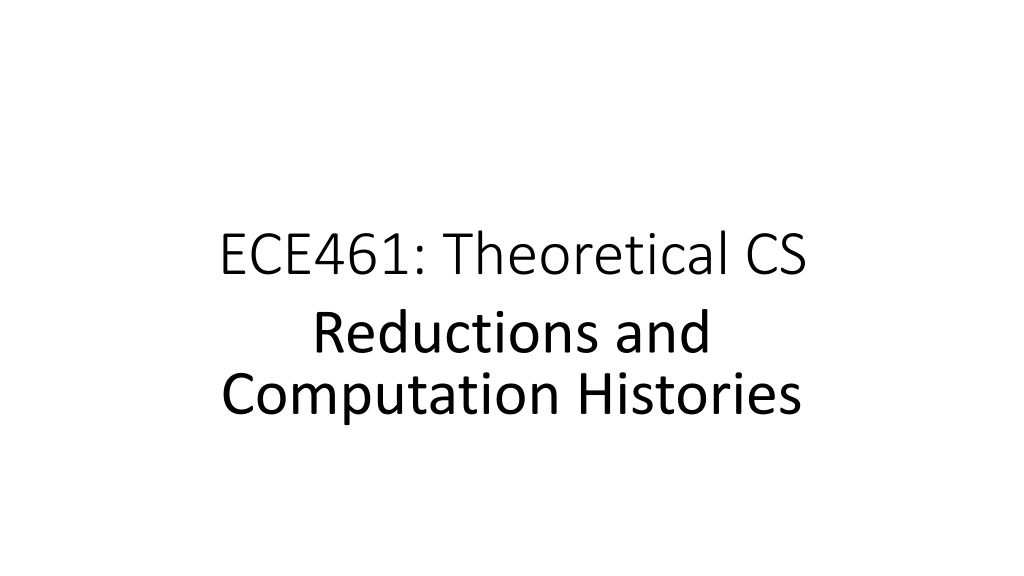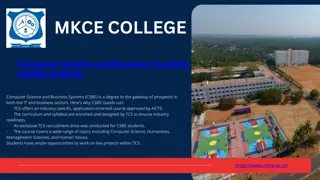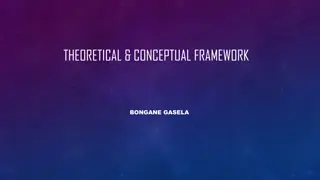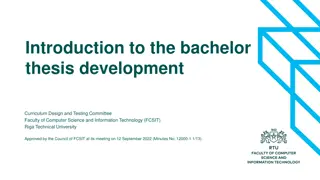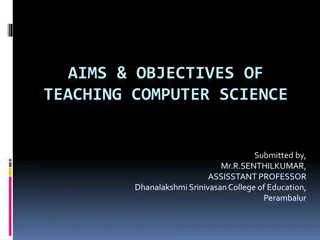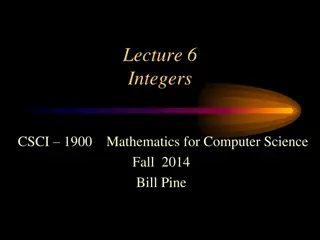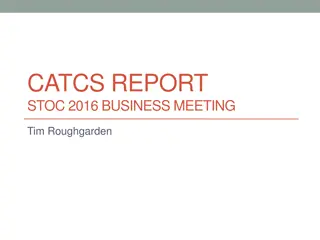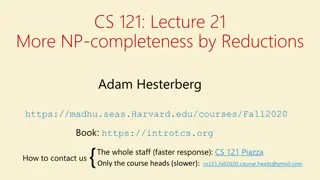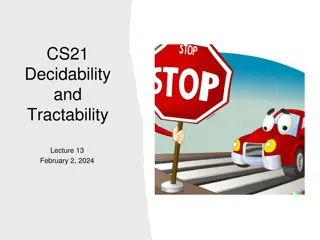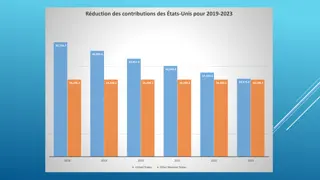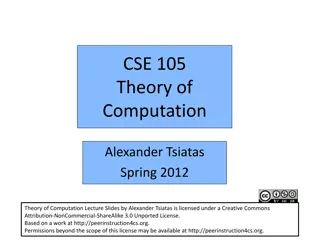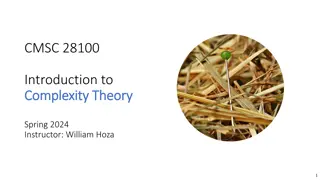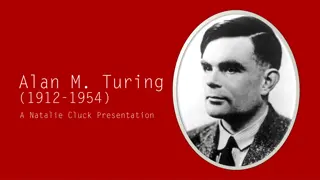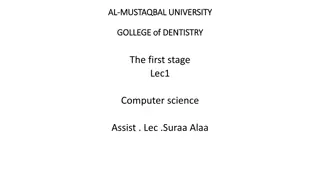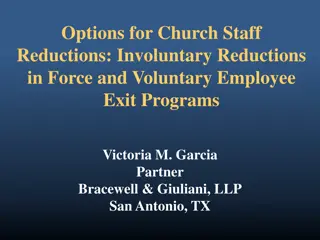Understanding Reductions in Theoretical Computer Science
Explore the concept of reductions in theoretical computer science, where problems are converted into others allowing solutions to one to solve the other. Learn how reductions can prove languages to be undecidable using examples like ATM and HALTTM. Follow along as we discuss the application of reductions to demonstrate the undecidability of various languages, including the famous halting problem. Dive into the intricacies of reductions and their role in proving computational limits.
Download Presentation

Please find below an Image/Link to download the presentation.
The content on the website is provided AS IS for your information and personal use only. It may not be sold, licensed, or shared on other websites without obtaining consent from the author. Download presentation by click this link. If you encounter any issues during the download, it is possible that the publisher has removed the file from their server.
E N D
Presentation Transcript
ECE461: Theoretical CS Reductions and Computation Histories
Brief Recap In our recent topics, we have been discussing Turing machines (TMs), providing us with the most powerful known formalism for modeling computation If we accept the Church-Turing thesis, then all algorithms can be implemented by Turing machines We discussed what it means for a language to be Turing-decidable (a.k.a. decidable) or Turing-recognizable; we also learned that some languages are undecidable (not decidable), and some are not Turing-recognizable In one previous topic, we saw some examples of decidable languages that were related to other languages and the formalisms that describe them These language were interesting in that deciding whether a string is a member of one of these languages is equivalent to answering a yes/now question about to the related formalism In our previous topic, we proved that the language ATMis an undecidable language Determining if a string is a member of this language is equivalent to determining if a specified TM accepts a specified input; this is known as the acceptance problem for Turing machines We proved that ATMis undecidable using an indirect proof and diagonalization In this topic, we will learn how to use reductions to prove that several additional languages are undecidable or not Turing-recognizable This topic is based on Chapter 5 of the textbook
Reductions Book: "A reduction is a way of converting one problem to another problem in such a way that a solution to the second problem can be used to solve the first problem." The book doesn't formally define the concept of reductions until Section 5.3, and we will also discuss a formal definition toward the end of this topic My wording (still not formal, but closer to the definition): A reduction is a function that maps instances of one language, L1, to instances of another language, L2, and maps non-instances of L1to non-instances of L2 For now, we will less-strictly use the concept of reduction to prove that certain problems are undecidable In this topic, we will, several times, reduce ATMto some other language, L Then, a Turing machine (or more generally, an algorithm) that decides L could be used to decide ATM This means that if L were decidable, then ATMwould also be decidable; since we already proved that ATMis undecidable, then L is also undecidable Once we prove that some language, L, is undecidable, we can reduce L to another language, L', to show that L' is also undecidable; logically speaking, we can say that reducibility obeys the transitive property Note that in DSA 2, we used reductions to prove that certain problems are NP-complete, and we will also do that later in this course In this topic, we will be using reductions to prove that certain languages are undecidable
HALTTM Our next language is: HALTTM= {<M, w> | M is a TM and M halts on input w} Of course, determining whether a string is part of this language is equivalent to determining whether a TM, M, halts on input w This is known as the halting problem halting problem Historically, the halting problem was the original problem that Turing showed was undecidable in 1936 This was also the problem that we proved was undecidable in DSA 2 In case anyone is reading along using the 2ndedition of the textbook, there is one point that needs explaining: Strangely, in the 2ndedition of the textbook, when the book first introduces ATM, it refers to it as the halting problem, although I have not personally seen the term halting problem refer to ATMin any other source Later, when the book introduces HALTTM, it explains the following in a footnote: "In Section 4.2, we used the term halting problem for the language ATMeven though HALTTMis the real halting problem. From here on we distinguish between the two by calling ATMthe acceptance problem." Thankfully, the 3rdedition of the textbook introduces ATMas the acceptance problem to begin with!
The Halting Problem is Undecidable Theorem 5.1 in the textbook states: "HALTTMis undecidable" It is easy to show that if the halting problem were decidable, then the acceptance problem would also be decidable Assume a TM, R, exists that decides the halting problem Then we could create a TM, S, that decides the acceptance problem, as follows: S processes input of the form <M, w> where M is a Turing machine and w is its input First, S uses R to decide if M halts on w If M does not halt on w, S rejects If M halts on w, then S simulates M on w (knowing it will halt) If M accepts w, S accepts <M, w>; if M rejects w, S rejects <M, w> Casually (but not technically) speaking, we can think of this as a reduction from ATMto HALTTM
ETM Our next language is: ETM= {<M> | M is a TM and L(M) = } Theorem 5.2 in the textbook states: "ETMis undecidable" We will prove this with using an indirect proof and a reduction (casually speaking) from ATM First, assume ETMis decidable, and R is a TM that decides it; we will show that we we could then create a TM, S, that is a decider for ATM, accepting input in the form <M, w> iff M accepts w As part of S's processing, it will create the encoding <M1> of another TM, M1, that operates as follows: M1compares its input, x, to w (remember that w is available to S to hardcode into the encoding <M1>) If x w, M1rejects; otherwise, if x = w, M1simulates M on input w; M1accepts if M accepts and rejects if M rejects Now we can explain the behavior of S, processing input <M, w> as follows: First, S creates the encoding <M1> as explained above Then, S runs R (a decider for ETM) on input <M1> If R accepts, S rejects; if R rejects, S accepts (so S does the opposite of R, unlike a typical reduction) Note that TM M1, encoded as <M1>, recognizes the empty language, , if and only if M does not accept w Also note that M1is never actually applied, and it does not matter if M rejects w of runs forever on w S as described would be a decider for ATM, which is impossible; therefore, the assumption that ETMis decidable, which lead to this contradiction, must be false
REGULARTM Our next language is: REGULARTM= {<M> | M is a TM and L(M) is a regular language} We will use another indirect proof and reduction from ATM First, assume REGULARTMis decidable, and R is a TM that decides it Then we could create a TM, S, that is a decider for ATM, accepting input in the form <M, w> iff M accepts w As part of S's processing, it constructs another Turing machine, M2, that works as follows: M2processes input x; if x is of the form 0n1n(which is a non-regular language), M2accepts Otherwise, M2simulates M on w; M2accepts if M accepts and rejects if M rejects Note that if M accepts w, then M2will accept all strings, and hence recognize a regular language; if M does not accept w, then M2will only accept strings of the form 0n1n, which is a nonregular language Note that M2will never actually be run on x, and it doesn't matter if M2would hang on w Now, S can process its input <M, w> where M is a TM and w is a string as follows: First, S creates the encoding <M2>, the encoding of M2described above as explained above Then, S runs R (a decider for REGULARTM) on input <M2> If R accepts, S accepts; if R rejects, S rejects S as described would be a decider for ATM, which is impossible; so, the assumption that REGULARTMis decidable, which led to the contradiction, must be false
EQTM Our next language is: EQTM= {<M1, M2> | M1and M2are TMs and L(M1) = L(M2)} Theorem 5.4 in the textbook states: "EQTMis undecidable" To prove this, we can now take advantage of the fact that reducibility is transitive Assume that EQTMis decidable; then there must be a TM, R, that decides it Given R, we could easily create a TM, S, that decides ETM S would process its input <M> as follows: Run R on <M, M'>, where M' is any TM that rejects all inputs If R accepts, S accepts; if R rejects, S rejects Since we already proved that ETMis undecidable, EQTMmust also be undecidable
Configurations (revisited) Recall that he current configuration of a TM is determined by the current content of the tape, the current location of the read-write head, and its current state It is often useful to be able to represent the configuration of a TM as a string We previously learned that we can denote the current configuration of a Turing machine, M, as uqv, where: uv is the contents of M's tape (all squares to the right of v contain blanks) q is the current state of M M's read-write head is over the leftmost symbol of v (if v is the empty string, M is positioned over the blank symbol just to the right of u) The start configuration of M can be represented as q0w, where w is the initial input The figure below graphically depicts a TM in configuration 1011q701111
Computation Histories The computation history for a TM is the sequence of configurations the machine goes through for a given input We can represent the computation history for a TM, M, on input w, as C1, C2, , Cl C1is the start configuration, which can be represented as q0w using the notation we previously covered Each ci, with 1 < i l, must legally follow from ci-1 If clis an accepting configuration (meaning that the state is qaccept), then this is an accepting computation history If clis a rejecting configuration (meaning that the state is qreject), then this is a rejecting computation history For a deterministic Turing machine (DTM), there is a single computation history given the input The notion of computation histories will be important to several reductions that we examine
Linear Bounded Automata We will now introduce another computation formalism, known as a linear bounded automaton (LBA) We can think of this as a Turing machine that is not allowed to move off the portion of the tape containing the input (if it tries to move left off the left-most square or right off the right-most square, it stays still) Book: "Using a tape alphabet larger than the input alphabet allows the available memory to be increased up to a constant factor" This idea allows us to effectively increase the memory by a linear factor with respect to the size of the input, which is where the name of the formalism comes from (and some sources define LBAs to have this ability) The book doesn't flesh this out, but I'll talk about it during the lecture Here is some history, based on other sources: The formalism was introduced in a 1960 paper by John Myhill A 1964 paper by S.-Y. Kuroda introduced the nondeterministic version and proved they recognize the class of context- sensitive languages This is part of the Chomsky hierarchy, above context-free languages but below Turing-recognizable languages As far as I can tell, it is still an open question whether deterministic LBAs are equally powerful to nondeterministic LBAs (e.g., that's what Wikipedia says, but I haven't seen definitive confirmation of this) Today, most sources use the term linear bounded automaton to refer to the nondeterministic version, and they refer to the deterministic version as a deterministic LBA explicitly However, our textbook uses the term linear bounded automaton to refer to the deterministic version I think that deterministic LBAs might be the best formalism to model what computers are capable of (I'll discuss this in class)
ALBA Our next language is: ALBA= {<M, w> | M is an LBA that accepts string w} Theorem 5.9 in the textbook states: "ALBAis decidable" Here, we have an excursion from the general topic, and prove that ALBAis a decidable language This may be surprising, since we have proven that ATMis undecidable We will be able to prove that ALBAis decidable by showing that there are a finite number of configurations any LBA can be in Consider an LBA, M, with q states, g symbols in the tape alphabet, and a tape of length n (the read-write head will never stray from this) Lemma 5.8 of the textbook states that the number of distinct configurations of M is qngn(I think the proof is obvious I'll discuss the reasoning in class) Given this fact, we can clearly construct a TM, L, that decides ALBAas follows: L processes input <M, w>, where M is an LBA and w is M's input L simulates M on w until M halts or for at most qngnsteps Note that if M uses qngnsteps, it means it must repeat an exact configuration, and therefore must be in an infinite loop (i.e., it will never halt) If M accepts w, L accepts; otherwise, if M rejects w or uses qngnsteps without halting, L rejects
ELBA(part 1) Our next language is: ELBA= {<M> | M is an LBA where L(M) = } Theorem 5.10 in the textbook states: "ELBAis undecidable" We will once again use an indirect proof and a reduction (casually speaking) from ATM First, assume ELBAis decidable, and R is a TM that decides it; then we could create a TM, S, that is a decider for ATM, accepting input in the form <M, w> iff M accepts w As part of S's processing, S constructs an LBA, B, that accepts its input string x if and only if x is an accepting computation history for M on w The figure above shows a possible format of the input, x, processed by B, assuming that # is a special symbol used to separate configurations in the input sequence B must check three things to decide whether x is an accepting computation history for M on w: 1. C1is M's start configuration 2. Each Ci+1legally follows Cifor 1 i < l 3. Clis an accepting configuration for M The book explains some of the details, but I think it is pretty obvious that an LBA is capable of this Note that if M accepts w, L(B) is non-empty; if M does not accept w, L(B) =
ELBA(part 2) Now, S can process its input <M, w> where M is a TM and w is a string as follows: S constructs an encoding for the LBA, B, described on the previous slide Recall that the construction of <B> relies on S's knowledge of M and w Also recall that the language of B is empty if and only if M does not accept w If M does accept w, then the language of B is non-empty, because B would accept M's accepting computation history (which must exist) Then, S applies R, a decider for ELBA, on input <B> Recall that we have assumed that ELBAis decidable at the start of our indirect proof; thus, such an R must exist If R accepts, meaning L(B) = , S rejects (since it means that M does not accept w) If R rejects, meaning L(B) is non-empty, S accepts (since it means that M accepts w) S would be a decider for ATM, which we know is impossible Therefore, the assumption that ELBAis decidable, which led to the contradiction, must be false; hence, ELBAis undecidable
ALLCFG(part 1) Our next language is: ALLCFG= {<G> | G is an CFG where L(G) = *} Determining whether a string is a member of this language is equivalent to determining if a CFG is capable of generating all strings that can be formed from its alphabet Theorem 5.13 in the textbook states: "ALLCFGis undecidable" We will once again use an indirect proof and a reduction (casually speaking) from ATM This reduction, like the last one, will involve computation histories Given the encoding of a TM, M, and its input, w The book at first states that we will construct a CFG, G, that generates all strings that are not accepting computation histories for M on w (although we will soon make a couple of modifications to this plan) Consider a computation history formatted as #C1#C2#...#Cl# In order for this to not be an accepting computation history for M on w, at least one of the following three things must be true: 1. C1is not the correct start configuration for M 2. Ci+1does not legally follow Cifor some 1 i < l 3. Clis not an accepting configuration for M
ALLCFG(part 2) Instead of constructing a CFG, we will construct a PDA that accepts all strings that are not accepting computation histories of M on w We have previously learned that any PDA can be converted to a CFG describing the same language (and vice versa), so this is equivalent to our previously stated goal The PDA will have to verify that at least one of the three criteria listed on the previous slide is violated Looking back at the criteria, determining if the first or third is violated should be simple, using separate branches of the PDA Determining if the second of the three criteria is violated would be more difficult using the PDA's stack We want to nondeterministically compare each Cito Ci+1, where i is in the appropriate range In general, all symbols from the two configurations must match, except those right around the read-write head, where the differences must match one of the valid transitions To simplify this, we will change the format used to represent computation history, such that every other configuration is specified in reverse order; this is demonstrated in the following figure: The book doesn't complete the proof, but at this point, you should be able to fill in the remaining details
The Post Correspondence Problem Next, we will discuss a problem known as the Post Correspondence Problem; based on other sources, this problem was introduced by Emil Post, in 1946 The problem can be described in terms of dominos, where each domino has a string on its top and bottom; for example, ab A collection of dominos might look like this: ca, The problem challenges you to determine whether there can be a list (I would say sequence) of dominos, such that the string of symbols across the tops is identical to the string of symbols across the bottoms Dominos from the collection are allowed to be repeated as many times as necessary If a list achieving the desired result is possible, any such list is called a match For some collections of dominos, a match is possible; for others, it is not For the collection of dominos specified above, a match is possible, as depicted here: a b a ca a, abc c ab,
Not all Collections of Dominos have Matches abc ab, ca a, acc ba Now consider the following collection of dominos: : This collection does not contain a match The textbook points out that we can realize this by noticing that the top string is longer than the bottom string for each domino There are also other ways to realize this; for example, here is what I originally noticed: Only the first domino starts with the same symbol at the top and bottom, so it must come first in any match That would mean that the second domino in a match must start with a c on the bottom, but no domino does that; so, no match is possible Given a collection of dominos, the Post Correspondence Problem asks us to determine whether the collection has a match This problem is not solvable by any algorithm! We will prove this by expressing the problem as a language, and then using an indirect proof that relies on a reduction from ATMinvolving configuration histories
PCP We will formulate the Post Correspondence Problem as a language, called PCP Let P be a collection of dominos, denoted P = A match is a sequence i1, i2, , il, where ti1ti2 til= bi1bi2 bil We can now express the PCP language as: PCP = {<P> | P is an instance of the Post Correspondence Problem with a match} Obviously, determining if a string is a member of this language is equivalent to deciding if an instance of the problem has a match Remember that each domino in P can be reused as many times as necessary Theorem 5.15 states: "PCP is undecidable" t1 b1, t2 b2, , tk bk
Proving that PCP is Undecidable (precursor) We want to show that if we could solve PCP, then we could solve ATM Consider a string <M, w>; we will construct a collection of dominos, P, that has a match if and only if M accepts w If there is a match, the string spelled out by both the top and bottom of the dominos will be an accepting computation history for M on w (with some extra symbols at the end) First, we are going to handle what the textbook refers to as "three small technical points" 1. We assume that M on w never attempts to move the read-write head off the left end of the tape, which requires "altering M to prevent this behavior" This, in my opinion, is the most complex of the three technical points I'll discuss how this can be achieved in class Exercise 5.8 (the answer is in the book) considers how to alter the proof so we can drop this assumption 2. If w = , we use the string in place of w when we construct our instance of P (this is simple, and allows us to handle rules when the tape starts blank and there are transitions involving a blank tape symbol) 3. We modify PCP such that the problem requires that the match starts with the first domino Thus, our reduction will be from ATMto the language: MPCP = {<P> | P is an instance of the Post Correspondence Problem with a match that starts with the first domino} At the end of the proof, we will show how MPCP can be reduced to PCP
ATMto MPCP, Part 1 We will assume that there is a TM, R, to decide MPCP, and we will construct a TM, S, to decide ATM S accepts <M, w> if and only if M accepts w, where M = (Q, , , , q0, qaccept, qreject) S will construct an instance of P' for MPCP such that P' has a match if and only if M accepts w As Part 1 of the textbook's construction of P', the first domino placed in P' is # t1 b1 #q0w1w2 wn#= Recall that MPCP (that we are reducing ATMto first) requires this first domino to start any match Thus, any possible match starting with collection P' must start as shown in the figure below:
ATMto MPCP, Parts 2 through 5 The textbook describes additional dominos added to P' as follows (I am keeping the wording from the textbook): Part 2. For every a, b and every q, r Q where q qreject, if (q, a) = (r, b, R), put brinto P'. Part 3. For every a, b, c and every q, r Q where q qreject, if (q, a) = (r, b, L), put rcbinto P'. Part 4. For every a , a ainto P'. Part 5. Put #and #into P'. The dominos added in these parts allow the simulation of M on w to proceed (we'll step through an example on the next few slides), except for handling accepting configurations (we'll add Parts 6 and 7 for that soon) The second domino in Part 5 allows blanks to be added to the end of configurations, to handle situations when the read-write head moves to the right end of the tape symbols and is over a blank For Parts 2 and 3, specifying that q qrejectonly matters if the transition function includes useless transitions out of qreject; we don't want a match that goes through qrejecton the way to qaccept qa cqa put # #
ATMto MPCP, Parts 2 through 5 Example Suppose we want to reduce an instance of ATMwhere: M's tape alphabet is = {0, 1, 2, } The input is w = 0100 The start state is q0 Three of the valid transitions are (q0, 0) = (q7, 2, R), (q7, 1) = (q5, 0, R), and (q5, 0) = (q9, 2, L) Based on that info, some of the dominos created due to parts 1 through 5 are (I am only listing the dominos that will be relevant for the part of the simulation we are examining): # From Part 1: #q00100# q00 2q7 0q50 q902 0 0, # # q71 0q5 From Part 2: and From Part 3: 1 1, and 2 2 From part 4: From part 5: Parts 3 through 5 would also lead to additional dominos (several for Part 3, one each for Parts 4 and 5)
ATMto MPCP, Simulating M on w, C0to C1 The dominos specified so far allow the start of a match to simulate the start of M processing w The string at the top and bottom of the match represent the start of a computation history Since we are dealing with MPCP for now, the match must begin using the domino from Part 1 The dominos from Parts 2 and 4 allow the bottom part of the match to simulate the step from C0to C1(the first two configurations in the computation history) as follows: Until we reach an accepting state, whenever the top string of a match completes the representation of a configuration, the bottom part of the match will be one valid configuration ahead The dominos are set up such that all transitions from configuration to adjacent configuration are valid
ATMto MPCP, Simulating M on w, C1to C2to C3 Then, the dominos from Parts 2 and 4 allow match to simulate the step from C1to C2as follows: Then, the dominos from Parts 3 and 4 allow the match to simulate the step from C2to C3as follows: The match proceeds to simulate a computation history until an accepting configuration is reached at the bottom of the match (assuming M accepts w) An example of what the right part of the match might look like at that point is:
ATMto MPCP, Handling the Accept State When the rightmost configuration in the bottom part of the match indicates an accepting configuration, we need to be able to complete the match That is, the top part of the match needs to somehow catch up to the bottom part when there is an accepting configuration at the bottom; the dominos added to P' so far, based on Parts 1 through 5, do not allow this aqaccept qaccept qaccepta qaccept Part 6 of the textbook's construction works as follows: For every a , put into P' and This allows the symbols to the left and right of to be eaten up, so to speak, one at a time, continuing the match as follows: qaccept## # To handle the rest, Part 7 of the textbook's construction of P' adds the following domino: This allows to complete the match as follows:
MPCP to PCP (part 1) So far, we have reduced ATMto MPCP That is, we have taken an instance of ATM, consisting of input <M, w>, and converted it to a collection of dominos P' We have shown that P' is a member of MPCP if and only if M accept w To achieve our original goal of reducing ATMto PCP, we need to reduce MPCP to PCP (remember that reducibility is transitive) Before explaining how to do this, the textbook introduces a new shorthand notation For any string u = u1u2 unof length n, the book defines u, u , and u as follows: u = *u1*u2*u3* *un u = u1*u2*u3* *un* u = *u1*u2*u3* *un* Note that there are asterisks before, after, or before and after each character of u
MPCP to PCP (part 2) Consider an instance of ATM that has been converted to a collection of dominos P' for the MPCP problem Denote that as: t1 b1 b2 We will now convert P' to P, defined as follows: t1 b1 , P forces the first domino to come first in any match for the original PCP problem because it is the only one that starts with the same symbol at the top and bottom After that, dominos can be used corresponding to the dominos in a match from the MPCP problem At the end, there will be an extra to eat up at the bottom; the final domino allows us to take care of that Now, we have successfully reduced ATMto MPCP to PCP If PCP were decidable, ATMwould also be decidable, which we know is false Hence, PCP is not decidable! t2 t3 b3 tk bk P = , , , , t1 b1 , t2 b2 , t3 b3 , , tk bk , P =
Defining Reducibility There are various ways that reducibility can be formally defined The textbook covers one method (in Section 5.3) called mapping reducibility Before we state the formal definition, we need to define the notion of a computable function Definition 5.17 states: "A function f: * *is a computable function if some Turing machine M, on every input w, halts with just f(w) on its tape" There are a few points I want to make about this: I believe this is the first time that the textbook is considering the output of the tape of a Turing machine to be significant! We discussed this during an earlier topic, but an algorithm can obviously do more than just answers a yes/no question (or accepts or rejects an input) Algorithms can, for example, compute arithmetic expressions, solve algebraic equations, find optimal paths in graphs, transform Turing machines, etc. The output of the algorithm is what winds up on the tape According to the Church-Turing thesis, Turing machines are believed to be as powerful as all reasonable formalisms, matching our intuitive notion of what algorithms can do
Mapping Reducibility Definition 5.20 states (I am keeping the book's wording exact): "Language A is mapping reducible to language B, written A mB, if there is a computable function f: * *, where for every w, w A f(w) B. The function f is called the reduction from A to B." The book doesn t specify how to read the double arrow, but it can be read as "if and only if" This means that the reduction, f, maps instances of A to instances of B; it also maps non-instances of A to non-instances of B The figure on the next slide helps to explain this Note that this mapping is neither one-to-one or onto; more specifically: Every string from the alphabet is part of the domain, and will get mapped to something Different strings can get mapped to the same thing Not every string in the range will necessarily have something map to it
Using Reductions to Prove (Un)Decidability Theorem 5.22 states: "If A mB and B is decidable, then A is decidable" This should be fairly obvious Given a string that may or may not be a member of A, we can use the reduction, f, to calculate f(w) Then we can use a decider for B to determine if f(w) is a member of B If f(w) is a member of B, w is a member of A If f(w) is not a member of B, w is not a member of A Corollary 5.23 states: " If A mB and A is undecidable, then B is undecidable" This should also be fairly obvious If B were decidable, then A would be decidable (according to Theorem 5.22)
HALTTM(revisited) Earlier, we showed that if we could decide HALTTM, we would be able to decide ATM, which we had previously proven is impossible; therefore, HALTTMis undecidable While we can casually think of the method used in that proof as a reduction, it is not a mapping reduction, as we have now defined it A mapping reduction would be a function that maps the input to ATM, <M, w>, to an input to HALTTM, <M', w'>, such that: <M, w> ATMif and only if <M', w'> HALTTM We can construct such a mapping reduction, implemented by a Turing machine F that performs as follows: F constructs a TM M' (but it does not run M') that does the following: M' runs M on x If M accepts, M' accepts If M rejects, M' purposely enters an infinite loop F outputs <M', w>; that is, it erases the original contents of the tape, and writes <M', w> Note that <M', w> is a member of HALTTMif and only if <M, w> is a member of ATM That means that F is a proper mapping reduction from ATMto HALTTM
Revisiting Other Previous Examples The proof that PCP is undecidable already included two mapping reductions The first was ATM mMPCP The second was MPCP mPCP Mapping reducibility obeys the transitive property, so applying the two reductions sequentially would give us ATM mPCP Now let's reconsider the proof that ETMis undecidable We showed that if ETMwere decidable, ATMwould be decidable, which we know is false; therefore, ETMis undecidable However, not only was the reduction casual, but even if we converted it to a mapping reduction similar to the method used, it would be a mapping reduction from ATMto ETM This is sufficient to show that ATMis undecidable, because decidability is not affected by complementation In fact, the book states that there is no mapping reduction from ATMto ETM; Exercise 5.5 asks you to prove this (the answer is given in the book)
Using Reductions to Prove (Un)Recognizability Theorem 5.28 states: "If A mB and B is Turing-recognizable, then A is Turing-recognizable" This should be fairly obvious Given a string that may or may not be a member of A, we can use the reduction, f, to calculate f(w) Then we can apply a recognizer for B to f(w) If the recognizer for B ever accepts f(w), then w is a member of A If the recognizer for B rejects f(w), then w is not a member of A The recognizer for B may never halt, but that's OK; we don't have a decider for A, but we have a recognizer for A Corollary 5.29 states: " If A mB and A is not Turing-recognizable, then B is not Turing- recognizable" This should also be fairly obvious If B were Turing-recognizable, then A would be Turing-recognizable (according to Theorem 5.28) This gives us two ways to prove that some language, L, is not Turing-recognizable One way is to take a non-Turing-recognizable language, such as ATM, and reduce it to L Another is to take the complement of a non-Turing-recognizable language, such as ATM, and reduce it to L The second method may not seem intuitive, but look back at Figure 5.21 (four slides back) If A mB, then A m B, and vice versa From here, we can reason that if A m B, then A mB
EQTM(revisited, part 1) In our previous topic, we proved that there must be some languages that are not Turing-recognizable We did this by showing that the set of languages given any alphabet is not countable; therefore, they can't all be recognized by a TM Later in the topic, we proved that if a language is both Turing-recognizable and co-Turing-recognizable (i.e., the complement of a Turing-recognizable language), it is decidable Therefore, if a language is Turing-recognizable but not decidable, it's complement must not be Turing- recognizable As an example, ATMis not Turing-recognizable Now we show that some languages are neither Turing-recognizable nor co-Turing-recognizable Earlier in this topic, we proved that EQTMis not decidable (via a casual reduction from ETM) Theorem 5.30 states something stronger: "EQTMis neither Turing-recognizable nor co-Turing-recognizable" To prove that EQTMis not Turing-recognizable, we could reduce ATMto it; instead, we'll reduce ATMto EQTM (as explained on the previous slide, this is sufficient) To prove that EQTMis not Turing-recognizable, we could reduce ATMto it; instead, we'll reduce ATMto EQTM
EQTM(revisited, part 2) First, we will prove that ATM mEQTMto show that EQTMis not Turing- recognizable; here is the mapping reduction: F processes input <M, w>, where M is a TM and w is a string F constructs the encodings for two TMs, M1and M2(it does not run either of them) M1rejects all inputs M2simulates M on w; if M accepts w, M2accepts its input, x (whatever x is) F outputs <M1, M2> If M accepts w, M2accepts everything, and it is different than M1(meaning <M1, M2> is a member of EQTM) If M does not accept w (it rejects or runs forever), M2accepts nothing, and it is the same as M1(meaning <M1, M2> is not a member of EQTM) Clearly, the output of F is a member of EQTMif and only if M accepts w
EQTM(revisited, part 3) Next, we will prove that ATM mEQTMto show that EQTMis not Turing- recognizable We will use a very similar mapping reduction to the last one (only the encoding of M1has changed): F processes input <M, w>, where M is a TM and w is a string F constructs the encodings for two TMs, M1and M2(it does not run either of them) M1accepts all inputs M2simulates M on w; if M accepts w, M2accepts its input, x (whatever x is) F outputs <M1, M2> If M accepts w, M2accepts everything, and it is the same as M1(so <M1, M2> is a member of EQTM) If M does not accept w (it rejects or runs forever), M2accepts nothing, and it is different than M1(meaning <M1, M2> is not a member of EQTM) Clearly, the output of F is a member of EQTMif and only if M accepts w
